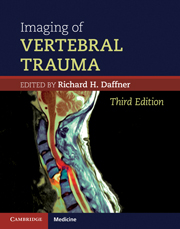Book contents
- Frontmatter
- Contents
- List of contributors
- Preface to the Third Edition
- Preface to the Second Edition
- Preface to the First Edition
- Acknowledgments
- 1 Overview of vertebral injuries
- 2 Anatomic considerations
- 3 Biomechanical considerations
- 4 Imaging of vertebral trauma I: indications and controversies
- 5 Imaging of vertebral trauma II: radiography, computed tomography, and myelography
- 6 Imaging of vertebral trauma III: magnetic resonance imaging
- 7 Mechanisms of injury and their “fingerprints”
- 8 Radiologic “footprints” of vertebral injury: the ABCS
- 9 Vertebral injuries in children
- 10 Vertebral stability and instability
- 11 Normal variants and pseudofractures
- Index
7 - Mechanisms of injury and their “fingerprints”
Published online by Cambridge University Press: 21 April 2011
- Frontmatter
- Contents
- List of contributors
- Preface to the Third Edition
- Preface to the Second Edition
- Preface to the First Edition
- Acknowledgments
- 1 Overview of vertebral injuries
- 2 Anatomic considerations
- 3 Biomechanical considerations
- 4 Imaging of vertebral trauma I: indications and controversies
- 5 Imaging of vertebral trauma II: radiography, computed tomography, and myelography
- 6 Imaging of vertebral trauma III: magnetic resonance imaging
- 7 Mechanisms of injury and their “fingerprints”
- 8 Radiologic “footprints” of vertebral injury: the ABCS
- 9 Vertebral injuries in children
- 10 Vertebral stability and instability
- 11 Normal variants and pseudofractures
- Index
Summary
Many classifications are used to define vertebral injuries. Some surgeons believe that using a classification system based on mechanisms is beneficial in planning surgical reduction and stabilization. Two of the earliest classifications were by Whitley and Forsyth [1] and Holdsworth [2], who emphasized mechanisms of injury. Roaf [3] made a plea to classify vertebral injuries according to the principles of classic dynamics. Unfortunately, this scholarly approach is not useful to radiologists. Gehweiler and coworkers [4] addressed the needs of radiologists by stressing the radiographic features of the Holdsworth classification.
In 1982, Allen and associates [5] reviewed a series of their own cases and observed a spectrum of injuries in the cervical vertebral column that they called phylogenies. They expanded the existing classifications along mechanistic lines and defined six common groups:
compressive flexion
vertical compression (pure axial loading)
distractive flexion
lateral flexion
compressive extension
distractive extension.
These investigators also proposed that the probability of an associated neurologic lesion was directly related to the type and severity of the lesion [5].
Ferguson and Allen [6] applied a similar mechanistic classification to thoracolumbar fractures and established the following categories:
compressive flexion, comprising three subcategories:
anterior wedge fracture
anterior wedge with posterior distraction, with facet fracture or dislocation, or with both
burst with middle element failure and retropulsion of bone fragments (classic burst fracture)
distraction flexion injuries, in which the abnormalities are primarily posterior (Chance-type fractures)
lateral flexion
torsional flexion (rotary “grinding”)
translational (shearing)
vertical compression (pure axial loading).
- Type
- Chapter
- Information
- Imaging of Vertebral Trauma , pp. 88 - 125Publisher: Cambridge University PressPrint publication year: 2011



